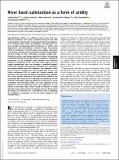| dc.contributor.author | Perri, Saverio | |
| dc.contributor.author | Suweis, Samir | |
| dc.contributor.author | Holmes, Alex | |
| dc.contributor.author | Marpu, Prashanth R | |
| dc.contributor.author | Entekhabi, Dara | |
| dc.contributor.author | Molini, Annalisa | |
| dc.date.accessioned | 2021-10-07T20:07:09Z | |
| dc.date.available | 2021-10-07T20:07:09Z | |
| dc.date.issued | 2020-07 | |
| dc.date.submitted | 2020-05 | |
| dc.identifier.issn | 0027-8424 | |
| dc.identifier.issn | 1091-6490 | |
| dc.identifier.uri | https://hdl.handle.net/1721.1/132786 | |
| dc.description.abstract | Soil-salinization affects, to a different extent, more than one-third of terrestrial river basins (estimate based on the Food and Agriculture Organization Harmonized World Soil Database, 2012). Among these, many are endorheic and ephemeral systems already encompassing different degrees of aridity, land degradation, and vulnerability to climate change. The primary effect of salinization is to limit plant water uptake and evapotranspiration, thereby reducing available soil moisture and impairing soil fertility. In this, salinization resembles aridity and—similarly to aridity—may impose significant controls on hydrological partitioning and the strength of land–vegetation–atmosphere interactions at the catchment scale. However, the long-term impacts of salinization on the terrestrial water balance are still largely unquantified. Here, we introduce a modified Budyko’s framework explicitly accounting for catchment-scale salinization and species-specific plant salt tolerance. The proposed framework is used to interpret the water-budget data of 237 Australian catchments—29% of which are already severely salt-affected—from the Australian Water Availability Project (AWAP). Our results provide theoretical and experimental evidence that salinization does influence the hydrological partitioning of salt-affected watersheds, imposing significant constraints on water availability and enhancing aridity. The same approach can be applied to estimate salinization level and vegetation salt tolerance at the basin scale, which would be difficult to assess through classical observational techniques. We also demonstrate that plant salt tolerance has a preeminent role in regulating the feedback of vegetation on the soil water budget of salt-affected basins. | en_US |
| dc.language.iso | en | |
| dc.publisher | Proceedings of the National Academy of Sciences | en_US |
| dc.relation.isversionof | 10.1073/PNAS.2005925117 | en_US |
| dc.rights | Article is made available in accordance with the publisher's policy and may be subject to US copyright law. Please refer to the publisher's site for terms of use. | en_US |
| dc.source | PNAS | en_US |
| dc.title | River basin salinization as a form of aridity | en_US |
| dc.type | Article | en_US |
| dc.identifier.citation | Saverio Perri, Samir Suweis, Alex Holmes, Prashanth R. Marpu, Dara Entekhabi, Annalisa Molini, River basin salinization as a form of aridity, Proceedings of the National Academy of Sciences Jul 2020, 117 (30) 17635-17642. © 2020 National Academy of Sciences | en_US |
| dc.contributor.department | Parsons Laboratory for Environmental Science and Engineering (Massachusetts Institute of Technology) | |
| dc.relation.journal | Proceedings of the National Academy of Sciences of the United States of America | en_US |
| dc.eprint.version | Final published version | en_US |
| dc.type.uri | http://purl.org/eprint/type/JournalArticle | en_US |
| eprint.status | http://purl.org/eprint/status/PeerReviewed | en_US |
| dc.date.updated | 2021-10-07T16:47:08Z | |
| dspace.orderedauthors | Perri, S; Suweis, S; Holmes, A; Marpu, PR; Entekhabi, D; Molini, A | en_US |
| dspace.date.submission | 2021-10-07T16:47:10Z | |
| mit.journal.volume | 117 | en_US |
| mit.journal.issue | 30 | en_US |
| mit.license | PUBLISHER_POLICY | |
| mit.metadata.status | Authority Work Needed | en_US |
